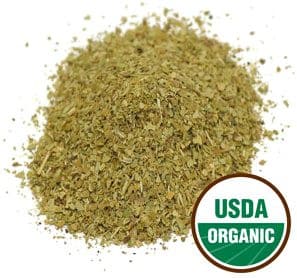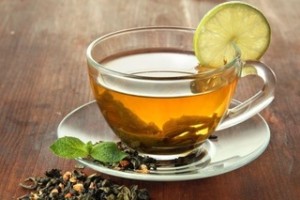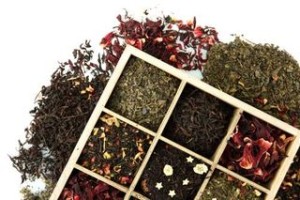Yerba Mate Tea Superfood
Table of Contents
NEWS: Yerba Mate Tea – This superfood is now available in the SANEStore as a convenient whole-food powder so you can more easily enjoy it in smoothies and recipes.

Yerba Mate is truly a remarkable herbal beverage which ranks exceptionally high in nutritional content among brewed or steeped drink products. Yerba mate (pronounced “Mah-Tay”) is a species of holly (family Aquifoliaceae) native to subtropical South America in northeastern Argentina, Bolivia, Uruguay, Paraguay and southern Brazil. Our organic yerba mate is shaded grown and has not been roasted or treated.
Yerba Mate is Packed with naturally occurring nutrients and antioxidants. There are 196 volatile (or active) chemical compounds found in the Yerba Mate plant. Of those, 144 are also found in green tea. Yerba Mate contains 11 polyphenols. Polyphenols are a group of phytochemicals. Phytochemicals (phyto- meaning plant) are recently-discovered compounds that act as powerful antioxidants and are considered to exhibit anti-cancer effects in mammals by strengthening an organism’s natural defenses and protecting it against cellular destruction (i.e. lycopene in tomatoes, flavonoids in blueberries, and isoflavones in soy). The polyphenol concentration of Mate has also shown a strong correlation to its overall antioxidant capacity. Furthermore, polyphenolic compounds found in Mate tea differ significantly from green tea because Mate tea contains high concentration of chlorogenic acid and no catechins. As a result, mate consumption complements green/black tea use quite well.
In addition to polyphenols, Yerba Mate leaves contain saponins (In fact, one recent study yielded 3 new saponins in the Yerba Mate leaf!) Saponins are phytochemicals that have been found to specifically stimulate the immune system and aid the body in protecting against disease. They possess significant anti-inflammatory properties.
Mate contains three xanthines: caffeine, theobromine and theophylline, the main xanthine being caffeine. Caffeine content varies between 0.7% and 1.7% of dry weight (compared with 0.3-0.9% for tea leaves, 2.5-7.5% in guarana, and up to 3.2% for ground coffee); theobromine content varies from 0.3-0.9%; theophylline is present in small quantities, or can be completely absent. A substance previously called “mateine” is a synonym for caffeine (like theine and guaranine).
Studies of mate, though very limited, have shown preliminary evidence that the mate xanthine cocktail is different from other plants containing caffeine most significantly in its effects on muscle tissue, as opposed to those on the central nervous system, which are similar to those of other natural stimulants. The three xanthines present in mate have been shown to have a relaxing effect on smooth muscle tissue, and a stimulating effect on myocardial (heart) tissue.
In 2005, researchers at the University of Illinois studied 25 different types of mate. They found the tea to contain “higher levels of antioxidants than green tea”… and, based on cell studies, “may help prevent oral cancer.” Other studies have shown yerba mate to possess up to 90% more metabolism-boosting nutrients than green tea!
Mate also contains high concentrations of inorganic compounds. The minerals aluminum, chromium, copper, iron, manganese, nickel, potassium, and zinc are of particular interest due to their importance in human metabolism and development.
According to Dr. Mowrey, Director of Mountainwest Institute of Herbal Sciences, one group of investigators from the Pasteur Institute and the Paris Scientific Society concluded that Yerba Mate contains “practically all of the vitamins necessary to sustain life.” They focused especially on Pantothenic Acid, remarking that it is “rare to find a plant with so much of this significant and vital nutrient… It is indeed difficult to find a plant in any area of the world equal to Mate in nutritional value.”
In addition, results from a study done by researchers at the University of Madrid assert a high content of mineral elements, especially K, Mg, and Mn, in Mate. They considered those findings “to be of great relevance” to the nutritional value of Mate infusions.
Each infusion of Mate contains:
Vitamins: A, C, E, B1, B2, Niacin (B3), B5, B Complex
Minerals: Calcium, Manganese, Iron, Selenium, Potassium, Magnesium, Phosphorus
Additional Compounds: Fatty Acids, Chlorophyll, Flavonols, Polyphenols, Trace Minerals, Antioxidants, Pantothenic Acid and 15 Amino Acids.
Why Try Yerba Mate Tea Superfood?
- Strong anti-oxidant
- Aids the body in protecting against disease
- Significant Anti-inflammatory properties
- Promotes weight loss
- Boosts the metabolism
- Supports the adrenal system
- Boosts energy
- Cholesterol bettering properties
- Elevates extracellular ATP, ADP, and AMP
- Exhibit significant cancer-fighting activity
Health benefits of Yerba Mate tea in weight loss
Because yerba mate has a greater caffeine content than green tea, it offers more fat burning and metabolism-boosting advantages. The extra caffeine found in yerba mate makes it a more effective appetite suppressant.
Yerba Mate Tea Aids in Weight Loss by
Blocking Fat Production
The chemical compounds found in yerba mate tea are responsible for its ability to block fat production. Mateine, the primary active chemical compound in Yerba Mate tea, blocks the enzyme known as Adenosine Mono-Phosphate (AMP) which is required for an enzyme involved in fat formation called Lipoprotein Lipase (LPL). By inhibiting this enzyme, yerba mate keeps more fat from being formed and instead encourages weight loss.
Yerba Mate Tea Increases Metabolism and Energy Levels
Besides caffeine, yerba mate also contains a stimulant known as theophylline which boosts metabolism and energy levels. This increased level of stimulation increases both mental and physical energy allowing for more output during exercise and more calories burned overall.
Supplementing with Yerba Mate tea for Weight Loss
Although drinking yerba mate tea can help you lose weight, it is important that you don’t rely on the tea as your only source of weight loss aid. Instead, incorporate a balanced SANE diet and exercise regimen with yerba mate in order to maximize results.
References
1. World Conservation Monitoring Centre (1998). Ilex paraguariensis. 2006. IUCN Red List of Threatened Species. IUCN 2006. www.iucnredlist.org. Retrieved on 9 May 2006.
2. Burtnik, Oscar José, “Yerba Mate Production”, 3rd Edition, 2006, retrieved on May 24, 2013
3. “Nativa Yerba Mate”. http://www.nativayerbamate.com/harvest.html. Retrieved 2011-07-18.
4. “FAOSTAT”. http://faostat.fao.org/site/339/default.aspx. Retrieved 2011-07-18.
5. “Mate: The Bitter Tea South Americans Love to Drink”, retrieved on May 30, 2013
6. “Flavored Yerba Mate”. http://www.ma-tea.com. Retrieved 2013-05-30.
7. “Iced Mate Drinks”. http://guayaki.com/category/7/Bottled-Yerba-Mate.html. Retrieved 2011-12-21.
8. “Mate: o chá da hora”. Retrieved 2012-09-04.
9. “Significado de ‘cimarrón'”. Retrieved 5 July 2013.
10. “Terere”. http://www.ma-tea.com. Retrieved 2013-05-30.
11. “Flor de agosto”.
12. McGee, J; Patrick, R S; Wood, C B; Blumgart, L H (1976). “A case of veno-occlusive disease of the liver in Britain associated with herbal tea consumption”. Journal of Clinical Pathology 29 (9): 788–94. doi:10.1136/jcp.29.9.788. PMC 476180. PMID 977780.
13. Dellacassa, Cesio et al. Departamento de Farmacognosia, Facultad de Química, Universidad de la República, Uruguay, Noviembre: 2007[page needed]
14. “Activities of a Specific Chemical Query”. Ars-grin.gov. Retrieved 2011-06-05.
15. Vázquez, A; Moyna, P (1986). “Studies on mate drinking”. Journal of ethnopharmacology 18 (3): 267–72. PMID 3821141.
16. Valduga, Eunice; de Freitas, Renato João Sossela; Reissmann, Carlos B.; Nakashima, Tomoe (1997). “Caracterização química da folha de Ilex paraguariensis St. Hil. (erva-mate) e de outras espécies utilizadas na adulteração do mate”. Boletim do Centro de Pesquisa de Processamento de Alimentos (in Portuguese) 15 (1): 25–36.
17. Bracesco, N.; Sanchez, A.G.; Contreras, V.; Menini, T.; Gugliucci, A. (2011). “Recent advances on Ilex paraguariensis research: Minireview”. Journal of Ethnopharmacology 136 (3): 378–84. doi:10.1016/j.jep.2010.06.032. PMID 20599603.
18. Scalbert, Augustin; Williamson, Gary. (2000). “Dietary Intake and Bioavailability of Polyphenols”. Journal of Nutrition 130: 2073S–2085S.
19. “Immune System”. http://www.ma-tea.com. Retrieved 2013-06-12.
20. DerMarderosian, Ara, ed. (1998). The Review of Natural Products. Facts and Comparisons Publishing Group., may inhibit some cancersVita, JA (2005). “Polyphenols and cardiovascular disease: effects on endothelial and platelet function”. American Journal Clinical Nutrition 81: 292S–297S.
21. Nagaya, N; Yamamoto, H; Uematsu (2004). “Gren tea reverses endothelial dysfunction in healthy smokers”. Heart 90: 1485–1486.
22. Bremner, Paul; Heinrich, Michael (2010). “Natural products as targeted modulators of the nuclear factor-KB pathway”. Journal of Pharmacy and Pharmacology (Journal of Pharmacy and Pharmacology) 54 (4): 453–47doi:10.1211/0022357021778637. Retrieved 12 June 2013.
23. “Relieves Allergies”. http://www.ma-tea.com. Retrieved 2013-06-12.
24. Swanston-Flatt, SK; Day, C; Flatt, PR; Gould, BJ; Bailey, CJ (1989). “Glycaemic effects of traditional European plant treatments for diabetes. Studies in normal and streptozotocin diabetic mice.”. Diabetes Research (Diabetes Research) 10 (2): 69–73.
25. Dulloo, Abdul; et al. (1999). Efficacy of a green tea extract rich in catechin polyphenols and caffeine in increasing 24-h energy expenditure and fat oxidation in humans. American Society for Clinical Nutrition (Am J Clin Nutr) 70 (6): 1040–1045. Retrieved 12 June 2013.
26. Wichtl, Max, ed. (2004). Herbal Drugs and Phytopharmaceuticals. Medpharm. ISBN 0849319617.
27. “Weight Management”. http://www.ma-tea.com. Retrieved 2013-06-12.
28. pages/Exercise-Aid.html “Exercise Aid”. http://www.ma-tea.com. Retrieved 2013-06-12.
29. Quettier-Deleu, C; et al. (2003). “Hawthorn extracts inhibit LDL oxidation.”. Pharmazie (Pharmazie) 58 (8): 577–581.
30. “Cardiovascular Aid”. http://www.ma-tea.com. Retrieved 2013-06-12.
31. Sanz, Tenorio; Isasa, Torija (1991). “Mineral elements in mate herb (Ilex paraguariensis St. H.)”. Arch Latinoam Nutr. (Arch Latinoam Nutr.) 41 (3): 441–454.
32. “Energy & Focus”. http://www.ma-tea.com. Retrieved 2013-06-12.
33. Klein, Siegrid; Rister, Robert (1998). The Complete German Commission E Monographs: Therapeutic Guide to Herbal Medicines. The American Botanical Council. ISBN 096555550X.
34. “Improves Mood”. http://www.ma-tea.com. Retrieved 2013-06-12.
35. “Sleep”. http://www.ma-tea.com. Retrieved 2013-06-12.
36. De Morais, Elayne C.; Stefanuto, Aliny; Klein, Graziela A.; Boaventura, Brunna C. B.; De Andrade, Fernanda; Wazlawik, Elisabeth; Di Pietro, Patrícia F.; Maraschin, Marcelo et al. (2009). “Consumption of Yerba Mate (Ilex paraguariensis) Improves Serum Lipid Parameters in Healthy Dyslipidemic Subjects and Provides an Additional LDL-Cholesterol Reduction in Individuals on Statin Therapy”. Journal of Agricultural and Food Chemistry 57 (18): 8316–24. doi:10.1021/jf901660g. PMID 19694438.
37. Dasanayake, Ananda P.; Silverman, Amanda J.; Warnakulasuriya, Saman (2010). “Maté drinking and oral and oro-pharyngeal cancer: A systematic review and meta-analysis”. Oral Oncology 46 (2): 82–6.doi:10.1016/j.oraloncology.2009.07.006. PMID 20036605.
38. Loria, Dora; Barrios, Enrique; Zanetti, Roberto (2009). “Cancer and yerba mate consumption: A review of possible associations”. Revista Panamericana de Salud Pública 25 (6): 530. doi:10.1590/S1020-49892009000600010.
39. Goldenberg, D; Lee, J; Koch, W; Kim, M; Trink, B; Sidransky, D; Moon, C (2004). “Habitual risk factors for head and neck cancer”. Otolaryngology – Head and Neck Surgery 131 (6): 986–93. doi:10.1016/j.otohns.2004.02.035. PMID 15577802.
40. Goldenberg, David; Golz, Avishay; Joachims, Henry Zvi (2003). “The beverage maté: A risk factor for cancer of the head and neck”. Head & Neck 25 (7): 595–601. doi:10.1002/hed.10288.
41. International Agency for Research on Cancer (1991). “Summary of Final Evaluations”. Coffee, Tea, Mate, Methylxanthines and Methylglyoxal. IARC Monographs on the Evaluation of Carcinogenic Risks to Humans. World Health Organization. p. 461. ISBN 978-92-832-1251-5.
42. Sewram, Vikash; De Stefani, Eduardo; Brennan, Paul; Boffetta, Paolo (2003). “Maté Consumption and the Risk of Squamous Cell Esophageal Cancer in Uruguay”. Cancer Epidemiology, Biomarkers & Prevention 12 (6): 508–13. PMID 12814995.
43. Pittler, M. H.; Schmidt, K.; Ernst, E. (2005). “Adverse events of herbal food supplements for body weight reduction: Systematic review”. Obesity Reviews 6 (2): 93–111. doi:10.1111/j.1467-789X.2005.00169.x. PMID 15836459.
44. Görgen, Milena; Turatti, Kátia; Medeiros, Afonso R.; Buffon, Andréia; Bonan, Carla D.; Sarkis, João J.F.; Pereira, Grace S. (2005). “Aqueous extract of Ilex paraguariensis decreases nucleotide hydrolysis in rat blood serum”. Journal of Ethnopharmacology 97 (1): 73–7. doi:10.1016/j.jep.2004.10.015. PMID 15652278.
45. Filip, Rosana; Lotito, Silvina B.; Ferraro, Graciela; Fraga, Cesar G. (2000). “Antioxidant activity of Ilex paraguariensis and related species”. Nutrition Research 20 (10): 1437–46. doi:10.1016/S0271-5317(00)80024-X.
46. Xu, Guang-Hua; Kim, Young-Hee; Choo, Soo-Jin; Ryoo, In-Ja; Yoo, Jae-Kuk; Ahn, Jong-Seog; Yoo, Ick-Dong (2009). “Chemical constituents from the leaves of Ilex paraguariensis inhibit human neutrophil elastase”. Archives of Pharmacal Research 32 (9): 1215–20. doi:10.1007/s12272-009-1905-7. PMID 19784576.
47. “History of Mate”. Establecimiento Las Marías. Retrieved 8 November 2011.
48. Real Academia Española. “Mate”. Retrieved on May 23, 2013
49. AULEX, “Online Quechua-Spanish Dictionary” Retrieved on May 23, 2013
50. Real Academia Española. “Yerba”. Retrieved on May 23, 2013
51. FERREIRA, A. B. H. Novo Dicionário da Língua Portuguesa. Segunda edição. Rio de Janeiro: Nova Fronteira, 1986. p.453
52. “Word Magic Spanish Dictionary” Retrieved on May 23, 2013
53. Webster’s Third New International Dictionary of the English Language Unabridged, 2002, shows the main entry for the word as ma•té or ma•te. The explanatory material for main entries on page 14a, headed 1.71, says “When a main entry is followed by the word or and another spelling or form, the two spellings or forms are equal variants. Their order is usually alphabetical, and the first is no more to be preferred than the second…”
54. The New Oxford American Dictionary
55. The Oxford English Dictionary
56. “American Heritage Dictionary of the English Language”. Dictionary.reference.com. Retrieved 2011-06-05.
57. “Merriam-Webster’s Online Dictionary”. M-w.com. 2010-08-13. Retrieved 2011-06-05.
58. “La yerba mate sigue ganando adeptos en países asiáticos”. Territorio Digital (Argentina). 24 January 2013. Retrieved 24 January 2013.









